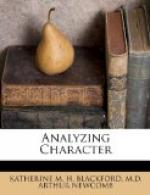Figures 27 and 28 and 29 and 30 show some very common types of the impractical man. Note the flatness of the brows in every case. Figures 32, 50, and 54 show the foreheads of practical men.
CHAPTER IX
HUNGRY FOR FAME
The born artist has a passion for creation. This is true whether his art expresses itself through paints and brushes, through chisel and stone, on the stage, through musical tones, through bricks and mortar, or through the printed page. The born artist may or may not have, as companion to his passion for creation, a hunger for fame, an ear which adores applause. Few artists, however, have ever become famous who were not spurred on by an eager desire for the plaudits of their fellows.
It is possible to have the passion for creation without the hunger for fame. It is also possible to have a hunger for fame without the passion for creation. In the “Light That Failed,” Kipling tells of little Maisie, who toiled and struggled, not to create beauty, but for success. Yet, poor Dick, who loved her, was forced to admit that there was no special reason why her work should be done at all.
Horace Annesley Vachell, in “Brothers,” tells the story of Mark Samphire’s tragedy. “When, after three years of most gruelling, hard work as an art student, he turned to his great master and asked: ’When you were here last you said to a friend of mine that it was fortunate for me that I had independent means. You are my master; you have seen everything I have done. Pynsent knows my work, too, every line of it. I ask you both: Am I wasting my time?’
“Neither answered.
“‘No mediocre success will content me,’ continued Mark. ’I ask you again: Am I wasting my time?’
“‘Yes,’ said the master gruffly. He put on his hat and went out.
“‘He’s not infallible,’ Pynsent muttered angrily.
“’Then you advise me to go on? No, you are too honest to do that. I shall not go on, Pynsent; but I do not regret the last three years. They would have been wasted, indeed, if they had blinded me to the truth concerning my powers.’”
WHEN THE DIVINE FIRE IS NOT AFLAME
The art schools of Paris! History, fiction, reminiscence, your own knowledge, perhaps your own experience, join in piling mountain-high the tale of wasted years, blasted ambitions, broken hopes and shattered ideals. Worse than this, perhaps, they tell of homes, galleries and shops disfigured with mediocre work and criminally hideous daubs.
The music studios of Paris, Berlin, New York, and other large cities, the schools of dramatic art, the theological seminaries, and the departments of literature in our universities could add their sad testimony. Theatrical managers, editors of magazines, publishers, art dealers, and lyceum bureaus are besieged by armies of aspiring misfits.




